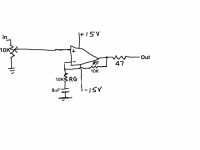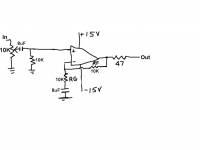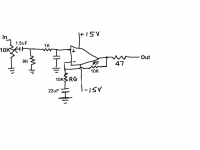I, too, am wondering why a 50MHz, 10uA Iin part is being used for audio?
Maybe the OP has a drawer full?
Maybe the OP has a drawer full?
The circuit in post 57 has 20k on one input and 10k on the other, so input current will generate a voltage offset. Of course, using lower value resistors will reduce this problem, but you have to be careful not to load the source too much. Is this an appropriate opamp for this application?
OK, now does the + input see 10K now?
Attachments
No, somewhere between 0 and 10k - depending on the volume setting. If the volume pot has a DC feed to it (e.g. no input coupling cap) then it will be 0 to 2.5k.
I, too, am wondering why a 50MHz, 10uA Iin part is being used for audio?
Funny...seems no one has even bothered noticing which op amp I've been trying to use until I provided a link to the datasheet.
Cliff, in case you haven't noticed, this is what this whole thread has been about--how I can use a higher Ib op amp in a audio circuit with a gain of 2 and have minimal DC offset.
Anyone can stick a FET-input op amp in a circuit and call it a day.
I don't have a drawer full, but I have several.
Nope... that give an impedance down to zero... it all depends on pot position.
OK, so do I need to put a 10K from + to ground? If not, what do I need to do the circuit in post 57 so the + sees 10K?
Put back the RF attenuating filter at the input.
I suggest you increase the 8uF in the NFB leg to 15uF, or 22uF.
Then you can experiment with the input cap to find what you want to hear.
Try using a small cap, say 220nF and listen.
Then add another 220nF in parallel (total 440uF). Do you hear any difference?
Then replace one 220nF with 1uF (total 1.22uF). Do you hear any difference?
etc .....
I suggest you increase the 8uF in the NFB leg to 15uF, or 22uF.
Then you can experiment with the input cap to find what you want to hear.
Try using a small cap, say 220nF and listen.
Then add another 220nF in parallel (total 440uF). Do you hear any difference?
Then replace one 220nF with 1uF (total 1.22uF). Do you hear any difference?
etc .....
Put back the RF attenuating filter at the input.
I suggest you increase the 8uF in the NFB leg to 15uF, or 22uF.
Then you can experiment with the input cap to find what you want to hear.
Try using a small cap, say 220nF and listen.
Then add another 220nF in parallel (total 440uF). Do you hear any difference?
Then replace one 220nF with 1uF (total 1.22uF). Do you hear any difference?
etc .....
OK, here's where I'm confused...won't adding the series resistor for the RF filter change the resistance of the + input unless both resistors' total is the same as Rf for lower offset?
Attachments
Everything is a compromise and unless you greatly add to the complexity some interactions are inevitable.
Your circuit meets the requirements for offset. The 1k and 9k give a total resistive path of 10k to ground. The input cap (the 1.5uf) and hf filter cap (whatever value you choose) will not upset the DC stability of the circuit.
One practical point is that the wiper of the pot, in seeing 9k at the wiper to ground, will have its "law" altered. That's no bad thing and it means you can use a linear pot rather than a log one even though the values aren't really correct to fake a log law.
Scroll down to "changing the law of a pot"
Potentiometers (Beginners' Guide to Pots)
Your circuit meets the requirements for offset. The 1k and 9k give a total resistive path of 10k to ground. The input cap (the 1.5uf) and hf filter cap (whatever value you choose) will not upset the DC stability of the circuit.
One practical point is that the wiper of the pot, in seeing 9k at the wiper to ground, will have its "law" altered. That's no bad thing and it means you can use a linear pot rather than a log one even though the values aren't really correct to fake a log law.
Scroll down to "changing the law of a pot"
Potentiometers (Beginners' Guide to Pots)
Strange as it might seem, people on an audio website don't carry around in their heads the main characteristics of an opamp which seems particularly unsuitable for audio. Even for audio-suitable opamps we may prefer to read the datasheet than rely on our memory.ammel68 said:Funny...seems no one has even bothered noticing which op amp I've been trying to use until I provided a link to the datasheet.
Strange as it might seem, people on an audio website don't carry around in their heads the main characteristics of an opamp which seems particularly unsuitable for audio. Even for audio-suitable opamps we may prefer to read the datasheet than rely on our memory.
OK...
Strange as it might seem, people on an audio website don't carry around in their heads the main characteristics of an opamp which seems particularly unsuitable for audio. Even for audio-suitable opamps we may prefer to read the datasheet than rely on our memory.
Nahh, it doesn't seem strange to me at all there, DF96.
I honestly didn't expect you to "carry around anything in your head" or recollect the AD827's specs from memory.🙂
Where on earth do these comments come from?
Yeah...I already know it's a video op amp and isn't "particularly suitable for audio".😉
While I respect all these opinionated replies, unfortunately there have been only a few actual helpful replies like the ones from Mooly and couple of other members here.
The AD827, being as it is a dual AD847 has at least one thing going for it for audio. That's a degenerated input stage, meaning better linearity than the usual fare opamps with 'naked' LTPs.
The AD827, being as it is a dual AD847 has at least one thing going for it for audio. That's a degenerated input stage, meaning better linearity than the usual fare opamps with 'naked' LTPs.
Yes, I considered going with two AD847's in place of the single AD827. They have a provision for offset null circuit, though I'm not sure if that would it be any help with DC offset when using changing resistance(volume pot) on the + input.
If you don't want our opinions, it might help if you shared less of your own opinions:
You asked for help, claiming that you knew the basics of design with opamps. Our initial replies assumed that you did. It quickly became clear that you did not, so Mooly helpfully spelled out the basics - which you could have found with Google or any textbook.
DF96, as with most things, the "basics" can be interpreted in many different ways. I meant that I understood how to calculate gain from the feedback resistors, power supply decoupling at the op amp's power pins, etc..
You have stated now, more than once, that "Mooly spelled out the basics-which you could have found with Google or any textbook". With all due respect...that's beginning to get a little old.🙂
First, I don't own any op amp design textbooks.
Second, after doing a Google search, I came up with a lot of articles stating what I already know, like calculating noninverting gain, etc..
With the exception of the webpage "working with cranky op amps" at tangentsoft.net, there is very little info. that I can find about using higher IB op amps in audio circuits while minimizing DC offset.
I'm grateful to Mooly for spelling out the basics, some of which I didn't know.
For instance, I had no idea about using a cap from one of the feeback resistors to ground.
I realize the AD826/827 are video op amps that are likely to oscillate.
Walter Jung constructed a circuit years ago using the higher performance AD811 current feedback video op amp as a buffer in a audio circuit.
I made had some PCB's manufactured for that design and I have to admit it sounds pretty darn good...for an all op amp circuit, anyway.
So I'm sure it can be done, though I'm not implying that it's easy in any way.
Thanks...
- Status
- Not open for further replies.
- Home
- Source & Line
- Analog Line Level
- How can this work?


